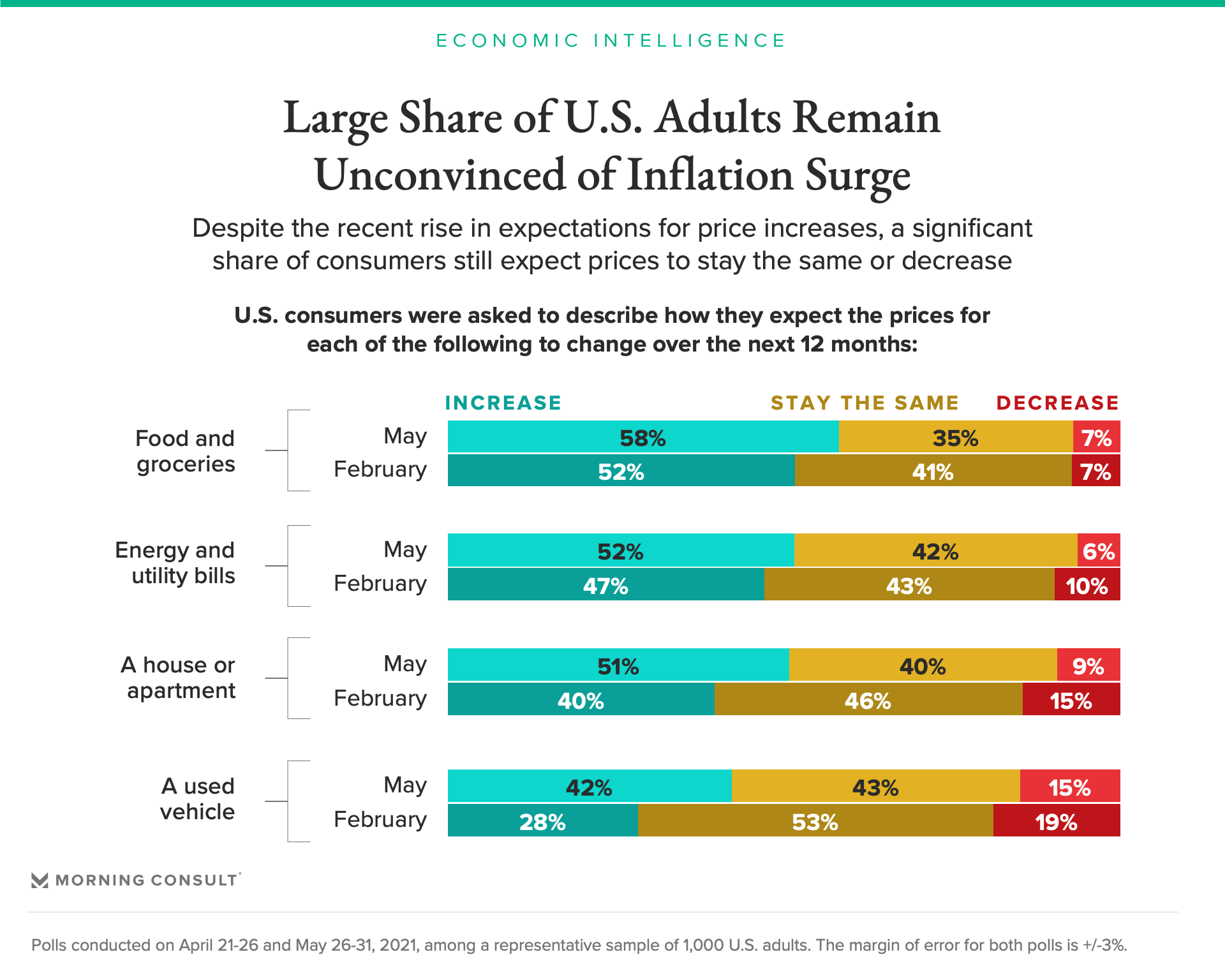Powell Believes Inflation Spike Will Remain Concentrated in Pandemic-Hit Sectors. So Do U.S. Consumers

Key Takeaways
Inflation fears are mounting on the back of last week’s 13-year high CPI reading, but a closer look at the data indicates that price growth is less broad-based and likely temporary in nature.
The largest drivers come from a sharp recovery in the sectors most heavily affected by COVID-19, especially where supply bottlenecks have arisen. When these outliers are stripped away, “trimmed” readings present a calmer view of inflation.
Morning Consult data shows that rising price expectations are also concentrated in industries most impacted by the pandemic, suggesting price pressures are likely to recede as supply and demand readjusts in the coming quarters.
Last week’s CPI reading of 5.0% marked a 13-year high for the United States’ headline consumer price metric, kindling inflation fears based on concerns regarding consumers’ growing comfort returning to normal, robust spending, resilient household balance sheets and unprecedented government stimulus. However, financial markets have remained calm since the CPI release, and the Federal Reserve signaled yesterday that it would maintain its present course with near-zero rates and bond purchases.
These narratives may appear in conflict, but the reasons for the discrepancy become clear when you look under the hood and examine the sources of the largest price increases last month. Corresponding with some of the biggest movements we see in household spending, the largest inflation drivers in May were concentrated in the sectors bouncing back from pandemic lows. Price spikes were most severe in areas where supply bottlenecks have also arisen; used car prices rose 7.3% month-over-month in May. When you strip away these outliers, the Federal Reserve Bank of Cleveland’s “trimmed-mean” CPI shows a calmer 2.6% reading in May.

As policymakers consider the recent spike in CPI, one of the most pressing questions is whether these sector-specific drivers will spread and impact inflation expectations, with consumers extrapolating rising prices in one sector to expect the same in others.
An analysis of Morning Consult data shows that, thus far, this is not the case. While inflation expectations for the next 12 months rose in May, increases were heavily concentrated in COVID-impacted sectors, signaling an awareness of the current price environment by consumers. For example, from April to May, the share of U.S. consumers who expect prices on trips and vacations to increase rose 8 percentage points, while the share expecting furniture prices to increase only rose by 2.6 percentage points.

This growth in the prevalence of increasing price expectation came as consumers’ attention refocused on travel and commuting. From January to May, for example, the share of consumers planning to purchase a trip or vacation in the next 12 months rose from 37.7% to 47.3%, the largest increase by category. As consumers turned their attention back to activities disrupted by the pandemic, perceived price increases in these sectors drove the most acute increases in inflation expectations.
While top of mind for consumers now, these sector-based inflation fears are unlikely to persist beyond the immediate period of rapid economic adjustment. Trips and vehicle purchases are infrequent for most households, meaning the spike in demand will likely diminish as pent-up demand eases and supply bottlenecks clear. Additionally, both items make up a relatively small portion of the CPI basket and household spending. Vehicle leases or loans accounted for 6% of monthly spending in May according to Morning Consult’s household spending tracker, compared to 43% for housing and 17% for groceries.
Inflation expectation data also indicates that, overall, U.S. consumers still anticipate relatively stable prices over the next 12 months. The chart below shows that the share of adults expecting price increases grew from February to May across the four largest spending categories. However, even after all the media coverage of price increases over the past few months, between 42% and 58% of respondents still expect prices to stay the same or decline.

After decades of moderate and disinflationary price growth, U.S. consumers’ expectations likely remain fairly well anchored. Only a broader-based and more prolonged period of price growth reinforced by strong wage growth is likely to uproot them. As previously described, persistent labor market slack suggests this is unlikely, but the Morning Consult team will be monitoring the data carefully for indications that a high rate of inflation will persist over the coming quarters.
As such, policymakers will likely continue to look beyond surging headline inflation reading. Federal Reserve Chairman Powell at the FOMC’s June meeting specifically pointed to category-level inflation and the transitory nature of supply bottlenecks as key drivers in the Fed’s expectation for inflation to fall and its decision to hold course on accommodative monetary policy over the coming months. In this environment, investors’ worst fears of a chaotic climb in interest rates are unlikely to unfold, and businesses, while adjusting prices upward to a degree, will likely continue to resist major price shifts in a bid to maintain market share. This response will in turn, help to keep a lid on price pressures.
The Morning Consult data from this analysis draws on monthly surveys of 1,000 respondents per country across the 15 largest economies that ask respondents questions regarding their spending and inflation expectations as well as their views of broader geopolitical and social risks. The surveys began January 2021, with some additions and edits occurring in February 2021.
Jesse Wheeler previously worked at Morning Consult as a senior economist.